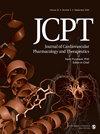舒比曲/缬沙坦前后射血分数降低的心力衰竭持续时间与心电图结果的相关性
IF 2.8
4区 医学
Q2 CARDIAC & CARDIOVASCULAR SYSTEMS
Journal of Cardiovascular Pharmacology and Therapeutics
Pub Date : 2022-01-01
DOI:10.1177/10742484221107799
引用次数: 1
摘要
目的:射血分数降低的心力衰竭(HFrEF)患者在接受沙库必曲/缬沙坦治疗后QRS持续时间的变化尚不完全清楚。本研究旨在评估沙库必曲/缬沙坦前后HFrEF诊断持续时间与心电图和超声心动图结果的关系。方法:我们纳入了2016年1月至2018年3月期间接受单纯沙库必曲/缬沙坦治疗≥3个月的HFrEF患者。根据HFrEF的持续时间将所有患者分为2组。通过HFrEF持续时间分析了沙库必曲/缬沙坦治疗后的心脏结局。结果:42例患者HFrEF持续时间<1年,47例患者HFr EF持续时间≥1年。QRS持续时间<1年组的平均差异小于≥1年组(-2.3 msec vs 6.3 msec;P=0.029)。然而,左心室射血分数(LVEF)的平均差异在≥1年的组中更高(13.8%vs 5.8%;P=0.008)。在调整患者人口统计和临床特征后,与<1年组相比,≥1年组的QRS持续时间显著延长(系数=11;95%可信区间[CI],0.3-21.7),LVEF恢复不良(系数=-10.3;95%置信区间−14.5至−6.1)。结论:在HFrEF持续时间≥1年的患者中,观察到沙库必曲/缬沙坦治疗后QRS持续时间延长,LVEF恢复不良。早期诊断HFrEF和适当的药物治疗可能有利于改善QRS持续时间和LVEF恢复。本文章由计算机程序翻译,如有差异,请以英文原文为准。
Duration of Heart Failure With Reduced Ejection Fraction Associated With Electrocardiographic Outcomes Before and After Sacubitril/Valsartan
Aim: Changes in QRS duration in patients with heart failure with reduced ejection fraction (HFrEF) after sacubitril/valsartan therapy is not fully understood. This study aimed to assess the association of duration of HFrEF diagnosis with electrocardiographic and echocardiographic outcomes between before and after sacubitril/valsartan. Methods: We included HFrEF patients who received naïve sacubitril/valsartan therapy for ≥3 months, between January 2016 and March 2018. All patients were divided into 2 groups based on their duration of HFrEF. Generalized linear models were analyzed the cardiac outcomes after sacubitril/valsartan therapy by HFrEF duration. Results: Among these, 42 patients were HFrEF duration of <1 year and 47 patients were ≥1 year. The mean difference of QRS duration was lesser in the <1-year group than in the ≥1-year group (−2.3 msec vs 6.3 msec; P = .029). However, the mean difference of left ventricular ejection fraction (LVEF) was higher in the ≥1-year group (13.8% vs 5.8%; P = .008). After adjusting for patient demographics and clinical characteristics, the ≥1-year group had a significantly prolonged QRS duration (coefficient = 11; 95% confidence interval [CI], 0.3-21.7) and an unfavorable LVEF recovery (coefficient = −10.3; 95% CI −14.5 to −6.1) compared with the <1-year group. Conclusion: Prolonged QRS durations and unfavorable LVEF recoveries after sacubitril/valsartan therapy were observed in patients with HFrEF duration of ≥1 year. Earlier diagnosis of HFrEF and appropriate medication treatment may be beneficial in the improvement of QRS duration and LVEF recovery.
求助全文
通过发布文献求助,成功后即可免费获取论文全文。
去求助
来源期刊
CiteScore
6.00
自引率
0.00%
发文量
33
审稿时长
6-12 weeks
期刊介绍:
Journal of Cardiovascular Pharmacology and Therapeutics (JCPT) is a peer-reviewed journal that publishes original basic human studies, animal studies, and bench research with potential clinical application to cardiovascular pharmacology and therapeutics. Experimental studies focus on translational research. This journal is a member of the Committee on Publication Ethics (COPE).

 求助内容:
求助内容: 应助结果提醒方式:
应助结果提醒方式:


